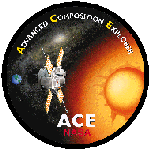
ACE (Advanced Composition Explorer):
ACE has six high resolution sensors and three monitoring instruments which
sample low-energy particles of solar origin and high-energy galactic particles.
The group at UNH participated in the development of the Solar Energetic Particle
Ionic Charge Analyzer (SEPICA) sensor. Charles
Smith recently brough the data processing for the MAG
instrument to UNH as well. ACE is in a halo orbit
at the Lagrangian Point.
After a brief delay, ACE was launched on Monday August 25, 1997 at 10:39 am. |
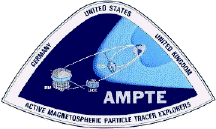 AMPTE
(Active Magnetospheric Particle Tracer Explorers): The AMPTE mission included three spacecraft designed to study the sources, transport, and acceleration of energetic magnetospheric ions. Also studied was the interaction between clouds of cool, dense, artificially injected plasma and the hot, magnetized, rapidly flowing natural plasmas of the magnetosphere and solar wind. All three spacecraft orbited in th equatorial plane. The apogee of UKS and IRM is 18.8Re and the apogee of CCE is 8.8Re. Our group is involved with the Ion Release Module (IRM) with Germany. We have some data online which may be downloaded. AMPTE
(Active Magnetospheric Particle Tracer Explorers): The AMPTE mission included three spacecraft designed to study the sources, transport, and acceleration of energetic magnetospheric ions. Also studied was the interaction between clouds of cool, dense, artificially injected plasma and the hot, magnetized, rapidly flowing natural plasmas of the magnetosphere and solar wind. All three spacecraft orbited in th equatorial plane. The apogee of UKS and IRM is 18.8Re and the apogee of CCE is 8.8Re. Our group is involved with the Ion Release Module (IRM) with Germany. We have some data online which may be downloaded. Launched: August 16, 1984 |
 Cluster II:
This mission will use 4 satellites to study, in three dimensions, the small scale structures in the Earth's plasma environment. While the original Cluster experiment was destroyed on June 4, 1996, due to a software bug in the then-new Ariane 5 launcher, Cluster II was launched (on two vehicles) on July 16 and August 9.
Cluster II:
This mission will use 4 satellites to study, in three dimensions, the small scale structures in the Earth's plasma environment. While the original Cluster experiment was destroyed on June 4, 1996, due to a software bug in the then-new Ariane 5 launcher, Cluster II was launched (on two vehicles) on July 16 and August 9.
The UNH Experimental Space Plasma Group is involved in the development of the ion
COmposition and DIstribution Function (CODIF)
analyzer. (Online pictures of the remains of the instrument are available.) Information on the Electron Drift Instrument (EDI), common to Cluster and Equator-S, is also available.
|
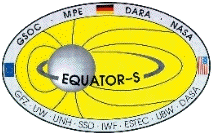 EQUATOR-S:
Equator-S provided high-resolution plasma, magnetic, and electric field measurements for: 1) the low latitude dayside magnetopause and its boundary layer, 2) the equatorial ring current region, and 3) the near earth equatorial plasma sheet for several regions which are not currently covered by any of the existing International Solar Terrestrial Physics missions. Dr. Lynn Kistler is working on the Equator-S Ion Composition (ESIC) instrument. Information on the Electron Drift Instrument (EDI), common to Cluster and Equator-S, is also available.
EQUATOR-S:
Equator-S provided high-resolution plasma, magnetic, and electric field measurements for: 1) the low latitude dayside magnetopause and its boundary layer, 2) the equatorial ring current region, and 3) the near earth equatorial plasma sheet for several regions which are not currently covered by any of the existing International Solar Terrestrial Physics missions. Dr. Lynn Kistler is working on the Equator-S Ion Composition (ESIC) instrument. Information on the Electron Drift Instrument (EDI), common to Cluster and Equator-S, is also available.
Launched: 2 December, 1997; mission ended April 30, 1998. |
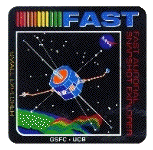
FAST (Fast Auroral Snapshot Explorer): This satellite studies particle accelleration into the aurora and has an orbit through the Earth's auroral regions. There are four instruments aboard the FAST satellite. Our group is involved with the Time-of-flight Energy Angle Mass Spectrograph (TEAMS). We have some interesting plots from the orbits available online for viewing. Launched: August 1996 |
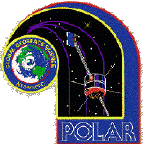 POLAR:
the second Global Geospace Science (GGS) mission. The spacecraft has 11 scientific instruments for investigation of a variety of phenomena in the Earth's polar regions. These instruments measure plasma, energetic particles and fields in the high-latitude polar regions, and energy input through the dayside cusp, determine characteristics of the auroral plasma acceleration outflow, provide global, multispectral, auroral images of the footprint of magnetospheric energy deposition into the ionosphere and upper atmosphere, help determine the role of the ionosphere in substorm phenonmena and in the overall magnetospheric energy balance.
POLAR:
the second Global Geospace Science (GGS) mission. The spacecraft has 11 scientific instruments for investigation of a variety of phenomena in the Earth's polar regions. These instruments measure plasma, energetic particles and fields in the high-latitude polar regions, and energy input through the dayside cusp, determine characteristics of the auroral plasma acceleration outflow, provide global, multispectral, auroral images of the footprint of magnetospheric energy deposition into the ionosphere and upper atmosphere, help determine the role of the ionosphere in substorm phenonmena and in the overall magnetospheric energy balance.
Launched: February 24, 1996
|
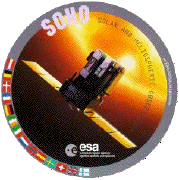 SOHO (SOlar and Heliospheric Observatory):
SOHO is in a halo orbit at the Lagrangian point and does remote sensing of the sun. SOHO was built in Europe with instruments from European and American scientists.
Dr. Möbius
is involved with the Charge, ELement, and Isotope Analysis System (CELIAS).
SOHO (SOlar and Heliospheric Observatory):
SOHO is in a halo orbit at the Lagrangian point and does remote sensing of the sun. SOHO was built in Europe with instruments from European and American scientists.
Dr. Möbius
is involved with the Charge, ELement, and Isotope Analysis System (CELIAS).
Launched: December 2, 1995 |
 STEREO (Solar-TErrestrial RElations Observatory: STEREO is still in its planning phases, but will include the PLASTIC (PLasma And SupraThermal Ion Composition) instrument, a collaborative effort of UNH, UBe, MPE, and GSFC. The mission concept is to allow for stereoscopic viewing of the Sun's output by launching two identical spacecraft, one of which will orbit ahead of the Earth, the other behind it. The PLASTIC experiment will provide plasma characteristics of protons, alpha particles and heavy ions. This experiment will provide key diagnostic measurements of mass and charge state composition of heavy ions and characterize the CME plasma from ambient coronal plasma. Dr. Antoinette Galvin, University of New Hampshire, will lead this investigation.
STEREO (Solar-TErrestrial RElations Observatory: STEREO is still in its planning phases, but will include the PLASTIC (PLasma And SupraThermal Ion Composition) instrument, a collaborative effort of UNH, UBe, MPE, and GSFC. The mission concept is to allow for stereoscopic viewing of the Sun's output by launching two identical spacecraft, one of which will orbit ahead of the Earth, the other behind it. The PLASTIC experiment will provide plasma characteristics of protons, alpha particles and heavy ions. This experiment will provide key diagnostic measurements of mass and charge state composition of heavy ions and characterize the CME plasma from ambient coronal plasma. Dr. Antoinette Galvin, University of New Hampshire, will lead this investigation.
Spacecraft development is scheduled to begin in 2001, with launch scheduled for 2004.
|
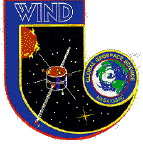 WIND
: Wind is the first Global Geospace Science (GGS) mission. Its instruments measure plasma, energetic particles, and magnetic fields in the magnetosphere and ionosphere, determine magnetospheric output to interplanetary space from the upstream region, and investigate basic plasma processes in the near-Earth solar wind.
WIND
: Wind is the first Global Geospace Science (GGS) mission. Its instruments measure plasma, energetic particles, and magnetic fields in the magnetosphere and ionosphere, determine magnetospheric output to interplanetary space from the upstream region, and investigate basic plasma processes in the near-Earth solar wind.
Launched: November 1, 1994
|









